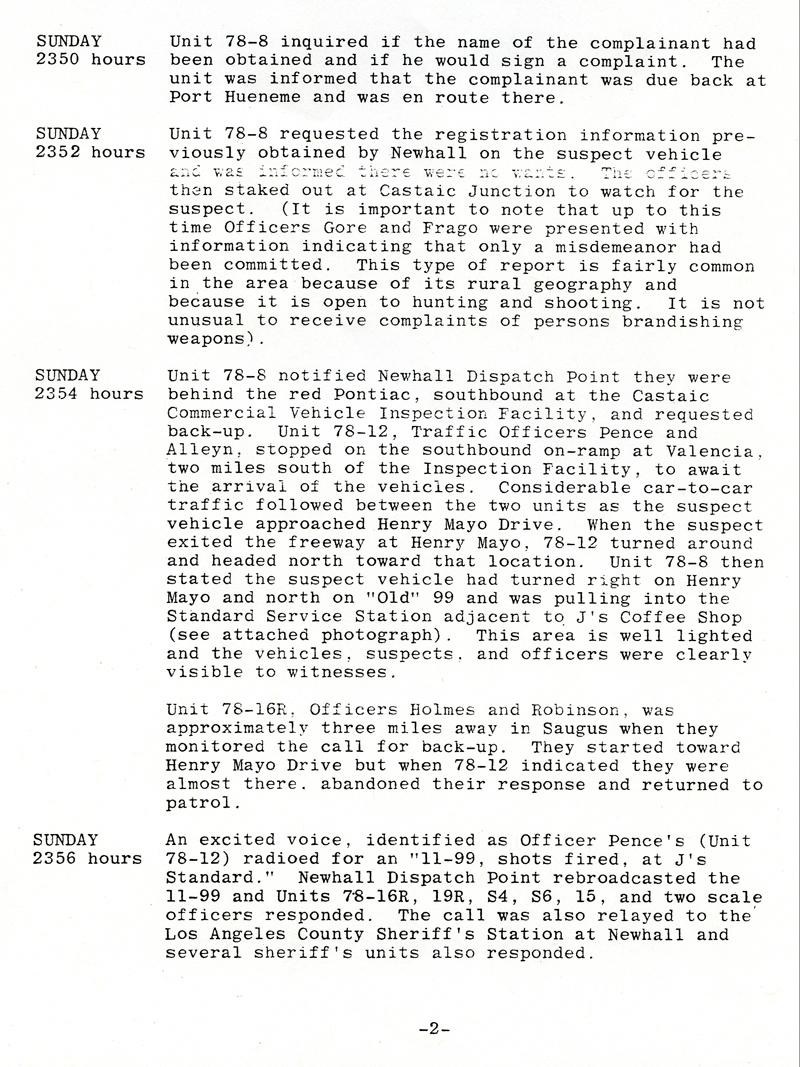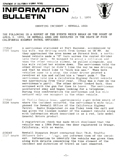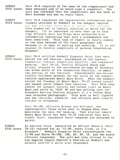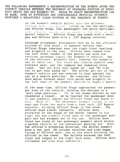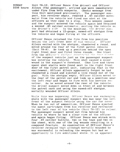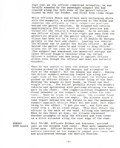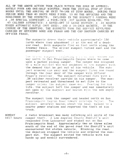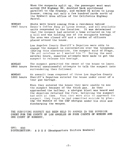DEPARTMENT OF CALIFORNIA HIGHWAY PATROL
INFORMATION BULLETIN
JULY 1, 1970
SHOOTING INCIDENT - NEWHALL AREA
THE FOLLOWING IS A REPORT OF THE EVENTS WHICH BEGAN ON THE NIGHT OF APRIL, 5, 1970 IN NEWHALL AREA AND RESULTED IN THE DEATH OF FOUR CALIFORNIA HIGHWAY PATROL OFFICERS:
SUNDAY
2350 hours
Unit 78-8 inquired if the name of the complainant had been obtained and if he would sign a complaint. The unit was informed that the complainant was due back at Port Hueneme and was en route there.
SUNDAY
2352 hours
Unit 78-8 requested the registration information previously obtained by Newhall on the suspect vehicle and was informed there were no wants. The officers then staked out at Castaic Junction to watch for the suspect. (It is important to note that up to this time Officers Gore and Frago were presented with information indicating that only a misdemeanor had been committed. This type of report is fairly common in the area because of its rural geography and because it is open to hunting and shooting. It is not unusual to receive complaints of persons brandishing weapons).
SUNDAY
2354 hours
Unit 78-8 notified Newhall Dispatch Point they were behind the red Pontiac, southbound at the Castaic Commercial Vehicle Inspection Facility, and requested back-up. Unit 78-12, Traffic Officers Pence and Alleyn, stopped on the southbound on-ramp at Valencia, two miles south of the Inspection Facility, to await the arrival of the vehicles. Considerable car-to-car traffic followed between the two units as the suspect vehicle approached Henry Mayo Drive. When the suspect exited the freeway at Henry Mayo, 78-12 turned around and headed north toward that location. Unit 78-8 then stated the suspect vehicle had turned right on Henry Mayo and north on "Old" 99 and was pulling into the Standard Service Station adjacent to J'S Coffee Shop (see attached photograph). This area is well lighted and the vehicles, suspects, and officers were clearly visible to witnesses.
Unit 78-16R, Officers Holmes and Robinson, was approximately three miles away in Saugus when they monitored the call for back-up. They started toward Henry Mayo Drive but when 78-12 indicated they were almost there, abandoned their response and returned to patrol.
SUNDAY
2356 hours
An excited voice, identified as Officer Pence's (Unit 78-12) radioed for an “11-99, shots fired, at J's Standard." Newhall Dispatch Point rebroadcasted the 11-99 and Units 78-16R, 19R, S4, S6, 15, and two scale officers responded. The call was also relayed to the Los Angeles County Sheriff's Station at Newhall and several sheriff's units also responded.
They called it the "Newhall Incident." It was the worst massacre of police officers in the 80 year history of the California Highway Patrol, and possibly the worst in American history. It changed police procedure forever thereafter — improved police training on how to approach a suspect, better weaponry, bullet proof vests — saving the lives of many police officers in the line of duty. It was the story of the bravery and sacrifice of four young CHP officers, and the story of a true American hero, a civilian bystander who risked his life under fire from gun toting suspects to try to save the life of a downed patrolman. On the evening of April 5, 1970, four CHP officers, Roger Gore, Walt Frago, James "Skip" Pence, and George Alleyn were brutally gunned down by two dangerous suspects in the lot of a Standard Service Station next to J's Coffee Shop on what is now the intersection of the Old Road and Magic Mountain Parkway in Valencia, California.
The two suspects were down and out career ex-convicts. They had met and became friends while in prison. Jack Twinning had just been released from the Federal Penitentiary in Tallahassee, Florida eleven months previously. At age 34, he had been in and out of eight federal prisons for various offenses since the age of 16. Bobby Augustus Davis had been released from prison 8 months previous and was serving his parole time in Houston, Texas. Both had tried and failed to land legitimate jobs after leaving prison. They met again in Houston and rode out to California to turn back to the "dark side" and score a big hit. After staying for a while in Sacramento and failing to pull off an intended bank robbery, they rode down to Los Angeles in a red Pontiac. As they drove south on Highway 99 between Gorman and Newhall, they noticed lots of construction along the highway and figured they could come back to steal explosives from the construction sites when they were ready to pull a robbery. In the car with them was a veritable armory of guns.
After renting an apartment in Long Beach, the suspects encountered an armored truck delivering cash to the Santa Anita Racetrack. They tracked the truck on its usual route and decided on a plan to rob the truck on a freeway ramp. But to accomplish their diabolical plan, they needed explosives. Late in the evening of April 5, 1970, they returned to the construction site between Newhall and Gorman on the northbound Golden State Freeway with the intent of procuring the explosives. Twinning left the car to search for explosives. Davis stayed in the car and parked on the side of the road behind a family stranded with an overheating radiator. With the family eying him suspiciously, Davis got nervous and made a quick U-turn on to the southbound side of the highway...
Ivory Jack Tidwell and his wife Pamela were traveling southbound on Highway 99 when they were almost sideswiped by Davis in the Pontiac as he made his U-turn. They took down the license plate number of the car. Tidwell was quite angry and pulled up alongside the Pontiac to tell the driver off. But Davis reacted by pointing a two-inch revolver at the Tidwells. Tidwell sped away and pulled off the highway further down the road to call the police and report the violent encounter.
The four young officers were relatively new to the CHP, having graduated from the police academy less than two years before the incident. Partners Roger Gore and Walt Frago spotted the Pontiac, now occupied by both suspects, as it headed south through the Newhall area. They followed the Pontiac as it pulled off on to Henry Mayo Drive (now Magic Mountain Parkway). James Pence and George Alleyn, driving in their patrol car northbound at Lyons Avenue, picked up the radio call from Gore and Frago and prepared to back them up. The suspects turned north on to what is now the Old Road and pulled into the driveway of a Standard Gas Station located next to J's Coffee Shop on the current site of Marie Callender's Restaurant. J's had just opened its business in 1969 or 1970. Prior to J's, there had been a Tip's Restaurant on this location (James Dean possibly stopped and ate there as he headed to his fatal accident outside Cholame in 1955).
The CHP officers flashed the red lights of their patrol vehicle as Gore got out to apprehend the suspects. While Gore patted down Davis, Frago covered him with a shotgun. Suddenly Twinning got out of the car and fatally shot Frago with two bullets from a .357 magnum. The horror had begun. Distracted by the gunfire from the passenger, Gore could not react in time as Davis shot him with a Smith and Wesson revolver.
"Newhall, 78-12! 11-99! Shots fired. J's Restaurant parking lot." Pence sent this desperate dispatch message as he and Alleyn pulled into the gas station driveway and saw their two comrades lying on the pavement. A gun battle ensued between the suspects crouched behind the Pontiac and the two officers. Despite their best efforts, both Pence and Alleyn were shot and killed during the battle with the suspects, Pence at close range in an execution style slaying.
Throughout history many tragedies have been accompanied by great heroism. The Newhall Incident was no exception. Gary Dean Kness was driving by J's Coffee shop on his way to work when he saw the gun battle taking place at the Standard station. As he saw one of the wounded officers fall to the ground, Kness raced out of his car to the officer's side, and tried to pull him out of the line of fire. While helping the officer, Kness saw one of the suspects approaching him with a sawed-off shotgun. He instinctively picked up the officer's shotgun and attempted to fire at the suspect, but the gun was empty. He then picked up a revolver and was able to fire off a shot at the suspect, who took off and ran wounded from the gunshot. Kness was honored by the CHP for his heroic efforts to save the officer, both on June 5, 1970 at a Memorial Wall dedication at the Highway Patrol office on the Old Road, and in April, 2008 when a portion of Interstate 5 was named for the four downed officers.
Never before had so many officers been killed in one incident. In the aftermath of the shooting, the two suspects took off in opposite directions by foot. Davis headed up San Francisquito Canyon Road where he was apprehended by police officers. He was eventually convicted and sentenced to death. His sentence was changed to life in prison when the California Supreme Court outlawed the death penalty. He remains in prison to this day. Twinning ended up barricaded in the home of Steven and Betty Jean Hoag on Pico Canyon Road near the Old Road, where he shot himself to death when the house was surrounded by the police. He had previously sworn that he would never return to prison.
The Newhall Incident left in its wake four young widows and nine fatherless children. Sympathy poured in from a stunned community as over 5000 letters were sent to CHP headquarters with nearly $100, 000 in donations for the families. But Gore, Frago, Pence, and Alleyn did not die in vain. As a result of their sacrifice, police procedures were re-examined and changed, making the jobs of police officers across the country much safer to this day. Many more lives of police officers may have been lost if not for the tragic loss of life on the worst day in the history of the CHP.
